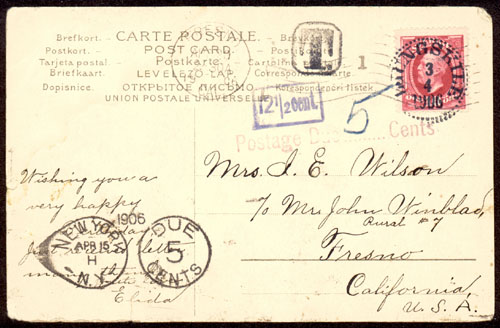 |
| 1906 Swedish picture post card with divided back (address side) |
|
|
| International 1902-1907 Postage Due Post Cards with Divided Backs |
by Jay Smith & Associates
Collectors of covers and post cards are sometimes puzzled by international post cards, dating from 1902 until 1 October 1907, that appear to bear the correct postage for a post card but have been charged postage due. Of the Scandinavian countries, these cards are most often seen from Sweden.
Almost all the cards in question have divided backs (address side): the right side for the address and the left side for a message. According to Svensk Posthistoria, 1855-1925 (this book is in stock), the divided-back post card was invented in 1901 by a German printer by the name of Hartmann. The cards started to see use in England in 1902, in France in 1903, in Russia and Norway in 1904, and in Sweden and Germany in 1905. These cards were accepted as normal post cards for domestic mail. However, under Universal Postal Union (UPU) regulations, they were not allowed as international post cards at the post card rate. Such cards were thus charged the letter rate until new regulations adopted by the 1906 Rome UPU Congress came into force on 1 October 1907.
In the 1902 through 30 September 1907 period, correctly franked (bearing letter rate postage instead of post card rate postage) divided-back post cards are rare. In the case of Sweden, the correct letter rate was 20 ore.
The divided-back Swedish post cards that are typically seen with postage due markings bear 10 ore postage for the post card rate. The additional 10 ore required to meet the international letter rate translates to 12 1/2 centimes (the international currency used by UPU member countries). To calculate the postage due, the receiving country doubled the shortage amount and converted the result to their currency. In the 1906 example illustrated above, the postage due was doubled to 25 centimes and then converted to U.S. cents at the rate of 1 cent per 5 centimes, for a total amount due of 5 cents.
[Until 1 October 1907, the country of origin marked the mail piece with the amount of postage that was short. After that date, the UPU regulations specified that the mail piece should be marked (still in centimes) with the amount to be collected (which was often, but not always such as in cases of forwarding, double the shortage).]
There are other possibilities for postage due post cards from this era. Post cards that were either oversize or undersize (but with undivided address side) were charged at the letter rate. Also, in this early period, international cards bearing Christmas Seals were charged at the letter rate (which helps to explain the great rarity of early Christmas Seals used on international post cards).
Additionally, post cards that were mailed at the printed matter rate were limited to five words of text (in addition to the sender's address). For Sweden, the international printed matter rate was 5 ore. If the card did not qualify for the printed matter rate, the shortage was marked as 6 1/4 centimes which would then be doubled by the receiving country and converted to their local currency.
The Swedish Postal History Society presents an excellent article on these markings, regulations, postage due charge calculations, etc., and includes many illustrations and information on the earliest known usages. Maybe you have an item that can be explained by their information or maybe you have an earlier usage! |

